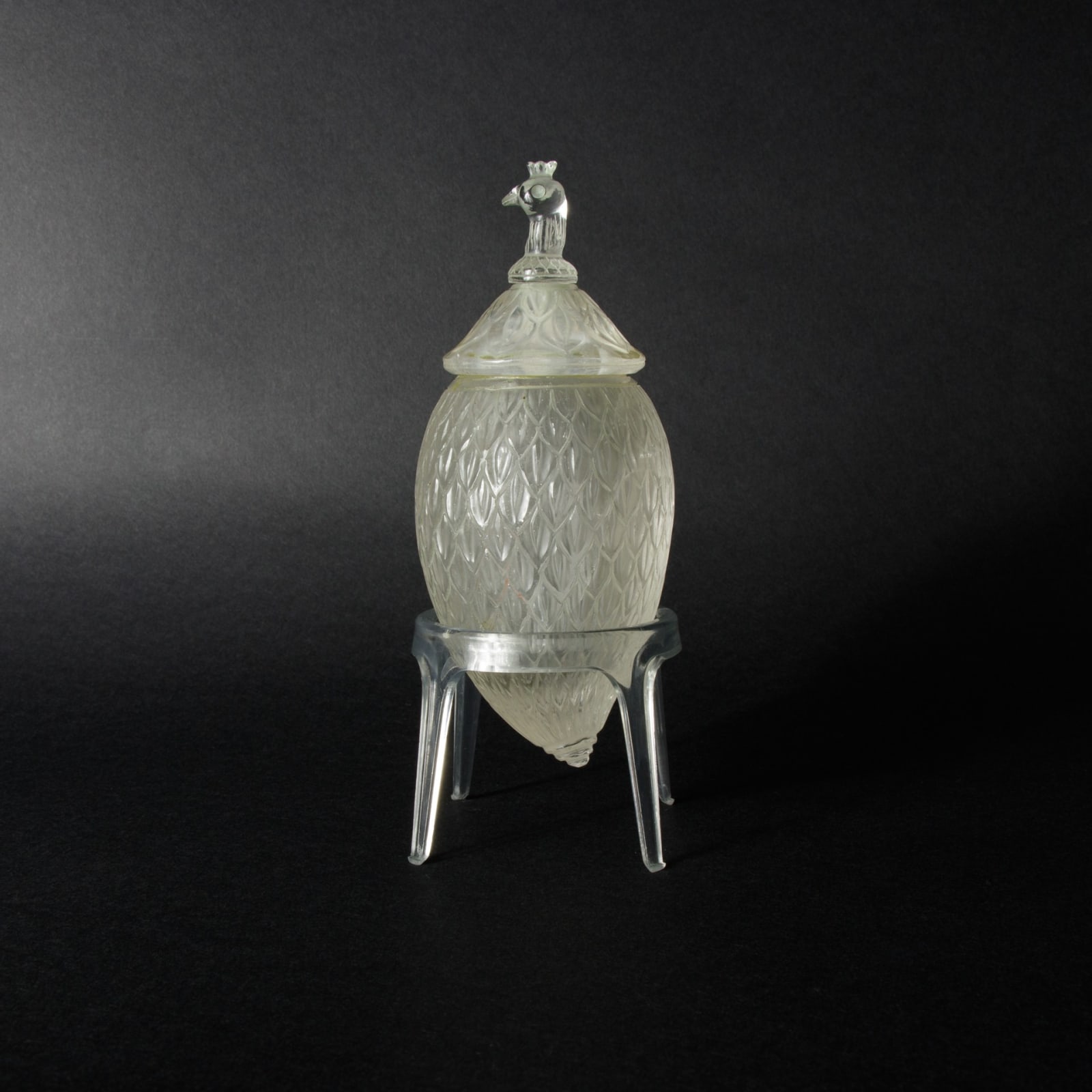A Mughal-style Rock Crystal Scent Bottle in the shape of a Mango, 16th-19th Century CE
Rock Crystal
13.8 cm
ES.8656
This rock crystal scent bottle has been carved in the shape of a mango and has been superbly decorated with naturalistic incisions of scale-like or feathers motifs. The neck is...
This rock crystal scent bottle has been carved in the shape of a mango and has been superbly decorated with naturalistic incisions of scale-like or feathers motifs. The neck is in the shape of a cone and has been glued to the main body, while a bird's head stands as a stopper.
The decoration of present bottle is a great example of the Mughal fascination for nature is demonstrated in the mango-shaped profile of the bottle and in the form of the stopper. An example of a rock-crystal bottle in the shape of a mango is a mid-17th century Mughal rock-crystal vessel set with gold, enamels and gems in the Metropolitan Museum of Art, New York (Acc. No. 1993.18), while other examples have been sold at Christie's (see Arts of India, 1 October 2012, lot 180).
The Mughal dynasty was founded in 1526 when Babur, a Central Asian Muslim prince, followed the example of his ancestor Timur (d.1405) and invaded the land he knew as Hindustan (the Indian subcontinent). Babur's languages were Turki, in which he wrote his memoirs, and Persian, the language of culture across Iran and Central Asia.
The "golden age" of Mughal art covered the period from about 1580 to 1650. Hindu and Muslim artists and craftsmen from the northern regions of the Indian subcontinent worked with Iranian masters in the the royal workshops. The combination of their different traditions and the technological and cultural transfer between different artisans resulted in a new distinctive style which included elements of all these different cultures.
Mughal's appreciation of hard stones has been inherited from the past: in India, carved and polished rock crystal was in use from ancient times to create Buddhist and Hindu religious artefacts. While the Islamic Near East had a long and established tradition of hardstone carving in order to manufacture vessels and other luxury items.
Floral motifs were probably derived from European engravings, likely seen by the Mughal artists in Netherlandish Biblical prints brought to the court by Jesuits. Animals and plant motifs can also be found in the borders of contemporary paintings and on metalwork, highlighting a fundamental difference between artistic production in the Mughal empire and in Europe: as in Iran, Central Asia and the rest of the subcontinent, no distinction is made between so-called 'fine' and 'decorative' art.
Under the reign of Shah Jahan (1628-1658), hard stones carving reached its peak, especially using jade and rock-crystal. Vessels, wine cups, boxes and containers were produced with both materials and very often they were set with precious stones in gold.
The decoration of present bottle is a great example of the Mughal fascination for nature is demonstrated in the mango-shaped profile of the bottle and in the form of the stopper. An example of a rock-crystal bottle in the shape of a mango is a mid-17th century Mughal rock-crystal vessel set with gold, enamels and gems in the Metropolitan Museum of Art, New York (Acc. No. 1993.18), while other examples have been sold at Christie's (see Arts of India, 1 October 2012, lot 180).
The Mughal dynasty was founded in 1526 when Babur, a Central Asian Muslim prince, followed the example of his ancestor Timur (d.1405) and invaded the land he knew as Hindustan (the Indian subcontinent). Babur's languages were Turki, in which he wrote his memoirs, and Persian, the language of culture across Iran and Central Asia.
The "golden age" of Mughal art covered the period from about 1580 to 1650. Hindu and Muslim artists and craftsmen from the northern regions of the Indian subcontinent worked with Iranian masters in the the royal workshops. The combination of their different traditions and the technological and cultural transfer between different artisans resulted in a new distinctive style which included elements of all these different cultures.
Mughal's appreciation of hard stones has been inherited from the past: in India, carved and polished rock crystal was in use from ancient times to create Buddhist and Hindu religious artefacts. While the Islamic Near East had a long and established tradition of hardstone carving in order to manufacture vessels and other luxury items.
Floral motifs were probably derived from European engravings, likely seen by the Mughal artists in Netherlandish Biblical prints brought to the court by Jesuits. Animals and plant motifs can also be found in the borders of contemporary paintings and on metalwork, highlighting a fundamental difference between artistic production in the Mughal empire and in Europe: as in Iran, Central Asia and the rest of the subcontinent, no distinction is made between so-called 'fine' and 'decorative' art.
Under the reign of Shah Jahan (1628-1658), hard stones carving reached its peak, especially using jade and rock-crystal. Vessels, wine cups, boxes and containers were produced with both materials and very often they were set with precious stones in gold.
